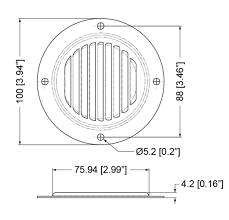Ventilation is an essential component of any building, ensuring the circulation of fresh air while expelling pollutants and excess moisture. Among the various ventilation systems, box vents have gained popularity for their simplicity and effectiveness. A box vent, also known as a roof vent or attic vent, is a critical part of a building's ventilation system, allowing for the exchange of air between the interior and exterior. In this article, we will explore the intricacies of box vents, their types, advantages, and the crucial role they play in maintaining a healthy indoor environment. Wikipedia.org
Understanding Box Vents
A box vent is a passive ventilation system designed to facilitate air exchange within a structure. Typically installed on a building's roof, these vents are simple in design but highly effective. They consist of a square or rectangular-shaped box with louvers, slats, or openings on all sides. The primary function of these openings is to allow air to flow in and out of the building. By doing so, box vents help prevent the accumulation of moisture and heat in enclosed spaces like attics, crawl spaces, and roofs.
Types of Box Vents
- Roof Louver Vents: Roof louver vents are the most common type of box vents. They are typically square or rectangular in shape and feature horizontal slats or louvers on all sides. These slats are designed to allow air to flow in and out while preventing the entry of rain, snow, or debris.
- Gable Vents: Gable vents are similar to roof louver vents, but they are installed in the gable ends of a building. Gable vents improve cross-ventilation by allowing air to flow through the attic or enclosed space from one gable end to the other.
- Soffit Vents: While not strictly box vents, soffit vents are closely related as they work in conjunction with roof vents. Soffit vents are installed under the eaves of the roof and allow fresh air to enter the attic. This air can then be expelled through roof louver vents or gable vents, creating a continuous flow of air.
Advantages of Box Vents
- Moisture Control: Box vents are effective at reducing moisture buildup in enclosed spaces. In areas like attics, excess moisture can lead to mold and mildew growth, rotting of wooden structures, and reduced insulation effectiveness. Box vents help prevent these problems by promoting proper ventilation and reducing humidity levels.
- Temperature Regulation: By expelling hot air from enclosed spaces during the summer and allowing for warm air to escape, box vents can significantly reduce the temperature within attics and crawl spaces. This helps maintain a more comfortable living environment and reduces the strain on HVAC systems, potentially leading to energy savings.
- Cost-Effective: Box vents are cost-effective because they require no electricity or moving parts to operate. They are passive systems that rely on natural convection and wind to facilitate air exchange, making them low-maintenance and economical.
- Easy Installation: Installing box vents is relatively straightforward and can often be done during the construction or renovation of a building. Their simple design and the availability of various sizes and styles make them a practical choice for both residential and commercial applications.
- Aesthetic Appeal: Box vents can enhance the aesthetics of a building by providing a functional and decorative feature on the roof or gable end. They are available in various materials, such as aluminum, steel, and PVC, and can be painted to match the building's color scheme.
The Role of Box Vents in Indoor Air Quality
Indoor air quality (IAQ) is a critical factor in maintaining a healthy living or working environment. Poor IAQ can lead to various health issues, including respiratory problems, allergies, and discomfort. Box vents play a crucial role in improving IAQ by ensuring proper air circulation and reducing pollutants within a building. Here's how they contribute to better indoor air quality:
- Removal of Stale Air: Stale air can accumulate in enclosed spaces, leading to a buildup of airborne contaminants and odors. Box vents facilitate the removal of this stagnant air, ensuring a constant supply of fresh outdoor air.
- Reduction of Allergens: Improved ventilation through box vents can help reduce the concentration of indoor allergens like dust mites, mold spores, and pet dander, which can trigger allergies and respiratory issues.
- Prevention of Mold and Mildew: Proper ventilation provided by box vents prevents excess moisture buildup, reducing the likelihood of mold and mildew growth. This is particularly crucial in damp or humid climates.
Conclusion
Box vents are unassuming but essential components of a building's ventilation system. They play a significant role in maintaining a healthy indoor environment by promoting air exchange, temperature regulation, and moisture control. Their cost-effectiveness, ease of installation, and aesthetic appeal make them a practical choice for various applications. By helping to improve indoor air quality and preventing structural damage caused by moisture and heat, box vents are an invaluable addition to any building, ensuring the well-being and comfort of its occupants. Visit official website onlyroofing.com

